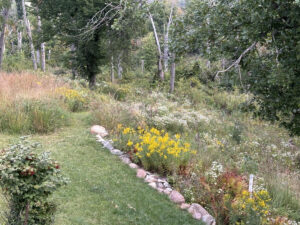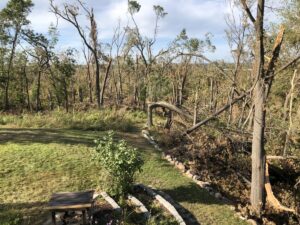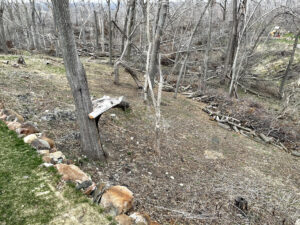Serendipitous Derecho
We sat on our back deck one early September evening remarking on the delightful wildflower progression we’ve enjoyed since early April. It is the serendipitous result of a disaster.
On August 10, 2020, a derecho’s 140-mile-an-hour wind knocked down almost all the trees. That led to days of chainsawing and hauling off firewood and brush. A few trees survived, but land that had been shady for decades was now in either partial or full sunlight.
What a change the storm made by transforming shade to sun! We planted some wildflower seeds, but the huge resurgence of flowers came from seeds that had remained dormant in the soil…..the seed bank … ..for years waiting for the right conditions to sprout.
- The once shady hillside lay exposed to the sun.
- Bare hillside
This Growing Season
April: Spring ephemeral flowers appeared. Anemones, spring beauties, Jacob’s Ladders, ginger, and bloodroot bloomed. They are called ephemerals because they don’t last long and soon disappear.
May: Our entire former forest was carpeted with toadstool-shaped May apples. Many sprouted beautiful white flowers that are, unfortunately, mostly hidden under their large leaves. After they fruited the plants faded away to be replaced by summer bloomers.
June, July, and August: Summer flowers added color. Pale purple, yellow, and purple coneflowers and woodland sunflowers bloomed amid thriving big and little bluestem grasses. Unlike earlier flowers, these stay in bloom for several weeks.
September: Goldenrod began blooming around the first of September and was soon joined by a fresh snowfall!!!!! Well, it wasn’t really snow, but so many white snakeroots came into bloom that our former woodland looked like newly fallen snow with golden sunflowers mixed in.
White snakeroot!

The hillside glows with goldenrod and a snowy carpet of snakeroot.
It’s toxic to most mammals and once killed people, but we’re not worried. If we had a grazing milk cow she might eat snakeroots and ingest a toxic alcohol that she’d void through her milk. Years ago, people drinking her milk may have sickened or died. It’s not a problem today since cows generally don’t graze in woods, pasteurization drives off the alcohol, and store-bought milk is usually a blend from many cows. So, without worry, we enjoy our snakeroot.
We are enjoying the progression but know it won’t last. Young oaks, hackberries, black cherries, and hickories have sprouted in the area. Someday, probably long after we’ve departed, our area will again be a shady woodland.



